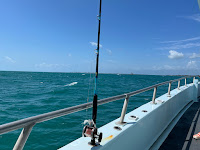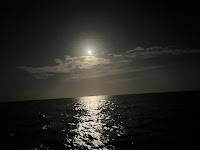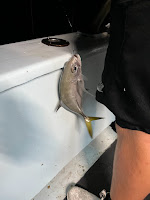This is post is on a week of fishing I did aboard the Reward Fleet with a group of friends as part of a trip we organized at school. We spent parts of four days from March 14th to March 17th fishing on the boat, going out in the morning of the first three days and at night on the last day. All around, it was an awesome week; we caught lots of fish, tried new fishing methods, and caught new species.
Day 1 - Monday, March 14, 2022
We started off the week with arguably the most intense morning we experienced. It was cloudy, windy, and very rocky out on the water. Soon after getting through the jetty, a good portion of the group felt quite seasick, which was obviously not a pleasant sight to see. Regardless, we set out to catch fish and soon enough we were hooking up.
We started off at a buoy to catch bait using sabiki rigs. We stopped the motor and put out a chum bag in the back of the boat, and tossed out our hooks. Despite being baitfish, it was still fun to catch them. Among the species we caught were Pilchards, Blue Runners, Speedos (Mackerel Shad, a long baitfish), Rainbow Runners, Leatherjackets, and Bermuda Chubs. I was rather excited as a multi species angler because some of these species were new to me. That being said, I was very likely the only one on the boat that was fine with catching Leatherjackets (not only are there better bait fish out there, but they can also be tough to handle with venomous spikes next to their dorsal and anal fins). Some of the spike rigs were tipped with small cut baits and some weren't. The tipped baits were a bit more successful at catching fish, but the fish they caught were generally larger and not the targeted baitfish.
Due to a lack of Pilchards, the plan was to troll about 10 to 15 minutes over to a hump (a general term used to describe underwater structures resembling small seamounts - they are made of Limestone in Florida). There, we would drop a few lines to the bottom for Snappers and Groupers while vertical jigging for Tunas and other game fish. However, we wouldn't get the chance.
About 5 minutes into the troll, we hooked up on a solid fish. I took the rod and began to fight the fish. The setup I was using had a planer, a device that keeps the attached trolling line deeper in the water column. The power of the Blackfin Tuna, known as being one of the best pound-for-pound fighters in Florida, made for an entertaining fight. I brought it in up to the planer, when the deckhand hand-lined the leader and pulled it over the transom. We had our first fish on deck!
The rest of the day was absolutely filled with action. It seemed as though every two minutes another fish was hooked on one of our four trolling lines. At one point we even had all four hooked up at once (we brought in three fish, one got away). Everyone that wasn't sick enough to decline a fight was able to catch Blackfin Tuna, Atlantic Bonito, and False Albacore. I'm glad to say that I'm lucky when it comes to seasickness; I have never been seasick and do not plan on being so anytime soon. I don't need to take Dramamine either.
After about a dozen tuna (and tuna relatives) were caught on the troll, we went in and cut the trip a bit short because of the prevalent seasickness. But before we docked, we anchored by Government Cut near the jetty at South Beach. Dropping down pieces of cut ballyhoo on chicken rigs, we were able to come away with a few more fish to end a very successful day. I caught a Bluestriped Grunt and a Red Grouper, the latter being an especially exciting catch - groupers are some of my favorite fish. Interestingly, the grouper spit out a crab and shrimp (large and whole enough that I am sure it came from the hook of a fisherman from the nearby South Pointe Pier) that it had recently ate.
Today was the most successful trolling trip I have ever had. The action was nonstop, and you could almost expect another rod to double over every two minutes. We filled up the cooler and (most of us) enjoyed the experience. It was rough on the water, but we did what it takes to catch the fish. We surely were rewarded.
-----------------------------------------------------------------------------------------------------------------------------
Day 2 - Tuesday, March 15, 2022
After a very successful day 1, we were excited to head out the next morning. The water was expected to be a bit less rough, but as we saw waves blowing up on the jetty rocks, we knew that it would be another tough trip. On top of that, it was going to rain, and hard. We could see it pouring offshore, right over the spots for which we were going. We made it clear, however, that we were not going to cut this trip short.
Soon after we left the jetty, while we were still inshore and had just put out our trolling lines, we hooked up. Milan took the rod and we caught a Spanish Mackerel. Very similar to the Cero Mackerel, which can also be caught off Miami, the distinguishable difference is in their almost identical yellow patterns: Cero Mackerel have bars as well as spots on their sides, while Spanish Mackerel only have spots. It was a new species for me, and the last of the three mackerel species that can be found in Miami - King, Cero, and Spanish.
We were glad that our trip started off on such a good note, but unfortunately the rest of the trip didn’t prove to be very productive. We trolled through the rain for another hour or so with no bites, stopping here and there to vertical jig and freeline live pilchards when Captain Wayne marked fish. At one point we saw two Sailfish jump out of the water right in front of us, but we were unfortunately not able to hook up on any. Although I didn’t catch anything on the jigs, and the current made vertical jigging difficult, I was glad to be able to try out a new method of fishing that I had been eager to learn about for a while. It’s a growing technique that involves dropping a specialized jig to the bottom and quickly jerking the rod and reeling to imitate an injured baitfish.
The only catches of the day were Cliff’s False Albacore and Mr. Muhlig’s Blacktip Shark. Both put up great fights that lasted for a few minutes. The False Albacore was caught on a dead ballyhoo, which the Captain called “tourist bait” because of its popularity on party boats in Miami that attract tourists; they generally just rig up a frozen ballyhoo and toss them out. The bait works, but it’s generally considered inferior to more expensive live bait. But as the Captain was saying, good fishermen can catch fish with worse bait and bad fishermen can come home empty handed with good bait. And there’s always an aspect of luck involved as well.
Muhlig’s shark was caught with light gear that Sam brought onboard for snapper. He was dismayed to see that it wasn’t a quality eating fish like a tuna or snapper, but it was a great entertaining fight on the light gear nonetheless.
It’s called fishing, not catching. It’s a game of give and take. Some days you catch a lot, and some days you catch a little. But no matter what, it’s always great being on the water, and every fishing trip and effort you make results in a positive for the future whether fish were caught or not. Looking back, it was respectable, almost honorable, our willingness to go out in such unfavorable conditions to the fishermen. As they say, weather separates the fishermen from the googans; those that are undeterred by the weather in their pursuit of fish, that choose to experience the real force of nature, are true fishermen. We finished the day with high hopes for the next trips to come.
--------------------------------------------------------------------------------------------------------------------------------





































































